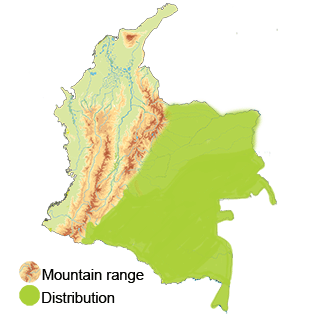White-bearded Hermit
The White-bearded Hermit (Phaethornis hispidus) Read in Spanish
Appearance: The White-bearded Hermit is a medium-sized hummingbird with distinctive features. It has a white or pale buff-colored throat and breast, contrasting with its green upperparts. These birds often exhibit white or buff-colored streaks on the face, extending from the bill to the throat. The White-bearded Hermit has a long, slightly curved bill for feeding on nectar, and its tail is typically dark in color.
Habitat: White-bearded Hermits are commonly found in humid forests, including montane forests, cloud forests, and forest edges in Colombia. They prefer habitats with dense vegetation and an abundance of flowering plants that provide nectar. These hummingbirds may also occur in secondary growth, shaded plantations, and gardens near forested areas.
Behavior: White-bearded Hermits exhibit hummingbird behaviors, such as feeding on nectar from flowers using their specialized bills. They are known for their agile flight and hovering abilities, allowing them to access nectar from a variety of flower species. These birds may also feed on small insects and spiders for additional protein in their diet.
Breeding: The breeding behavior of the White-bearded Hermit involves courtship displays by the males to attract females. Nests are cup-shaped and constructed using plant fibers, moss, and spider silk, placed on tree branches or vines. Female White-bearded Hermits incubate the eggs and care for the young, with both parents participating in feeding and raising the chicks.
Conservation Status: The White-bearded Hermit's is categorized as "Least Concern" by the International Union for Conservation of Nature (IUCN).
Distribution
The White-bearded Hermit (Phaethornis hispidus) is primarily found in the eastern and southern regions of Colombia. These regions include areas within the eastern Andes mountains, the Amazon rainforest, and the Orinoco River basin. The White-bearded Hermit prefers habitats such as humid lowland and montane forests, forest edges, and secondary growth with abundant flowering plants that provide nectar for these hummingbirds. They may also occur in areas with dense vegetation and suitable conditions for foraging and breeding.
Taxonomy
The White-bearded Hermit (Phaethornis hispidus)
- Kingdom: Animalia
- Phylum: Chordata
- Class: Aves (Birds)
- Order: Caprimulgiformes
- Family: Trochilidae
- Genus: Phaethornis
- Species: Phaethornis hispidus
Vocalization
The White-bearded Hermit (Phaethornis hispidus)
- Chirps and Chatters: These high-pitched chirps and chatters are often heard during interactions between individuals, such as courtship displays or territorial disputes.
- Whistles and Trills: The White-bearded Hermit may produce whistling or trilling sounds, especially during aggressive interactions or when defending its territory.
- Buzzing and Humming: Hummingbirds like the White-bearded Hermit also produce buzzing or humming sounds with their wings during flight, which can add to the overall auditory experience when observing these birds.
- Calls and Vocalizations: In addition to sounds produced during flight and interactions, the White-bearded Hermit may have specific calls or vocalizations used for signaling to mates, warning of potential threats, or communicating within their social groups.





